With the legalization of hemp in a number of U.S. states, the market recognizes new opportunity in a number of sectors from the health properties of CBD oil to renewable building materials that can result from the cultivation of this versatile plant. It’s not without its challenges, though, and primarily among them is how to dry product at scale quickly and economically without damaging its beneficial properties.
One method for drying hemp closely resembles the established “Wisconsin Method” for drying another member of the Cannabaceae family, Humulus Lupulus, also known as hops. The appeal to this process is that it excels at preserving valuable terpenes, minimizes equipment spend and lowers the operating costs compared to other methods.
Step 1: Determine your harvest rate/amount to determine your drying room/chamber capacity.
The ideal situation is to build multiple airtight chambers by whatever means possible (e.g. drywall, plastic tents, vinyl sheets) to dry your hemp in. The size of the chamber should be sufficient to hold one days’ worth of harvest.
You could build a room and continuously load it with product, but you can’t allow the hemp to sit without drying or it will rot. This means you will have hemp in multiple stages of drying, and it will be difficult to manage. Having a single, uniform loading and unloading for a single chamber will allow you to better manage product quality and dryness.
First, determine the daily harvest rate and the volume this will take up in your barns or drying facilities. The below diagram represents your product on racks and hanging from the ceiling in some sort of plastic box erected inside your current structure. The smaller you can make the structure, the better off you will be. This will reduce the volume of air (CFM) and dehumidification capacity needed to dry the product because both will be able to focus on the product instead of drying the rest of the space around the plant. It also forces more contact between the air and the product, which is what provides the drying potential.
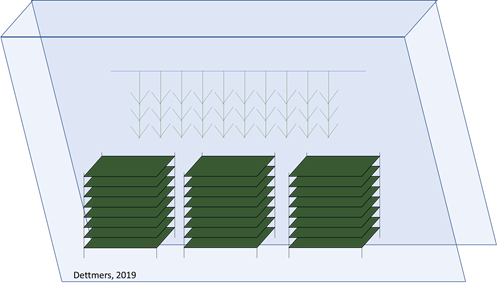
Step 2: Determine the outside air flow.
Upon loading the space, move as much outside air through that space as is feasible. The idea is to use the “free” outside air to remove as much moisture as possible, which is referred to as running in “open” mode because we are open to the outside air.
Be certain the air you are bringing in comes from outside, returns to the outside and does not recirculate back through the hemp.
Set up a scenario where the air is forced to pass around/through as much product as possible. If the product on the racks is packed too deep or too close together, the air will not pass through it, which will reduce the drying effectivity. The only thing that is drying the hemp is contact with air, so provide plenty of space. You may want additional fans inside the space to push air through the racks and direct it up toward the hemp hanging from the ceiling.
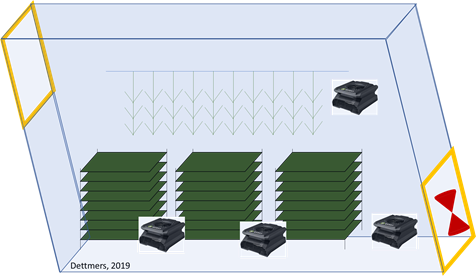
The amount of air moving through the space ideally would have a velocity of 1 foot per second, though the packing of the product in the room affects this number. To calculate the CFM needed, measure the height and width of the room. This is the “face area” the fan sees. The depth of the room is irrelevant.
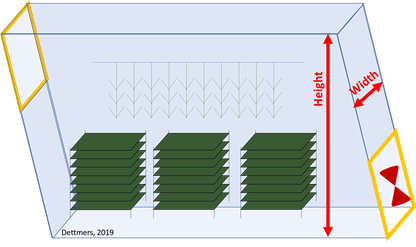
To calculate the CFM:
Air velocity [ft/sec] x 60 sec/min x height [ft] x width [ft] = ft3/min = CFMAs an example, let’s say this chamber is 15 feet high, 10 feet wide and you want air at a velocity of 1 foot per second:
1 ft/sec x 60 sec/min x 15 ft x 10 ft = 9,000 CFMAgain, 1 foot per second is the minimum amount of air that should move through the space. In drying other products, 3 to 4 feet per second is acceptable, depending on how the product was positioned in relation to the incoming air. The more air you pass through, the faster the product will dry. The fans inside the space used to move the air around the product do not tally toward the air flow going through the chamber. They are simply mixing the air to provide better contact.
Step 3: Determine the amount of time spent in “open” mode.
This is more trial-and-error art than science. The drying time in this mode will depend upon:
How much air flow is contacting the product and how wellThe relative humidity of the air (which is dependent upon outdoor conditions)The product’s “desire” to give up moisture and how low moisture content will go for the available relative humidityThe time available to the operator to dry in this mode vs. using dehumidificationA product’s “desire” to give up moisture is expressed in an isotherm diagram as shown below for hops, the closest botanical cousin to hemp/cannabis. Note: at this point, it does not appear that an isotherm for hemp/cannabis is readily available.
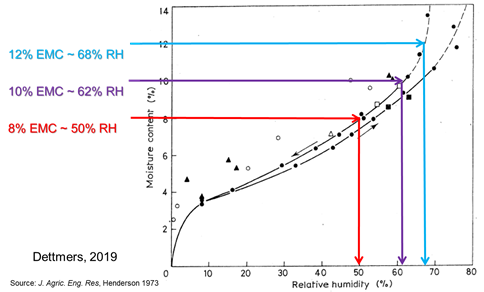
From this diagram, you can see that for every equilibrium relative humidity, there is a corresponding equilibrium moisture content. So, at 68% RH, the hops would eventually equilibrate to 12% moisture content.
If you note at the far right of the diagram, the curves are turning nearly straight up. This means that even on a cool evening with 99% RH, it’s still advantageous to pass outside air through the product because at this point in the drying process, it’s eager to give up water. If you do nothing, it’s likely you’ll find a chamber full of rot in the morning.
The lower the RH, the faster the product will dry. One way to do this is to warm up the air. The below graph shows you the amount of RH reduction you can expect by heating the air. The warning is the warmer the air is, the more damage there is to product. The terpenes, flavors, aromas and other volatiles you are trying to preserve will be driven away faster at higher temperatures. Use heat sparingly. A good rule of thumb is to never go above 100 degrees Fahrenheit in the drying chamber.
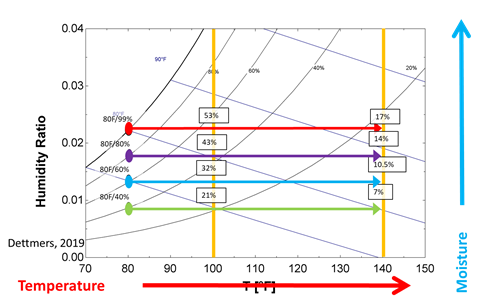
To determine how much heat you need for a temperature rise, the formula is:
Q = 1.08 x CFM x (Tout – Tin)Q = Heat needed [Btu/hr]CFM = Air volume [CFM]Tout = Air temperature leaving heaterTin = Air temperature entering heaterIf using electric resistance, don’t forget:
1 kW = 3,413 Btu/hrLet’s go back to the 9,000 CFM as an example. Let’s say it was 60 degrees Fahrenheit at evening, and you wanted to warm the air to 90 degrees Fahrenheit to dry the product faster:
Q = 1.08 x CFM x (Tout – Tin)Q = 1.08 x 9,000 CFM x (90F – 60F) = 291,600 Btu/hr = 85.4 kWTo achieve this, you would either need a 300,000 btu/hr furnace or a 90 kW electric resistance heater.
Be careful if using a direct-fired propane heater or similar. Water is byproduct of combustion.
In general, without heat and if located in the humid upper Midwest, for example, most agricultural products will drop to 20% to 40% moisture content in 18 to 24 hours.
Step 4: Switch to “closed” mode and determine dehumidification capacity.
The first step of this process is understanding the concept of moisture content and how it relates to moisture removed. The formula for calculating moisture content is:
M% = ((Ww-Wd)/Ww) x 100M% = moisture content (%)WW = wet weight of the sampleWd = weight of the sample’s dry matter (no water left in the product at all)To show this process in a table and graph, for 1,000 pounds of product starting at 80% moisture content would look like this:

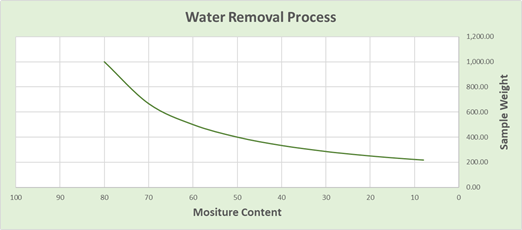
As you can see, water removal vs. moisture content is not a linear process. For example, going from 80% MC to 70% MC removes 333 pounds of water (one third of the total weight). Going from 40% to 30% removes 47.6 pounds. As you go to lower and lower moisture content, there is less drying potential in the outside air, and there is less moisture to remove from the air.
It’s important to note at this point, the moisture content of hemp at harvest time and the target moisture content when complete may vary based on specific conditions and personal preference. Eighty percent MC for harvest is being referenced as an assumed average. Ten percent MC for finishing is a common number for hops, but results may vary. Some state laws require cannabis to be dried to a certain moisture content, so that is another potential stopping point.
At some point, the operator needs to decide it’s time to give up on the “open” mode and its free outside air and close up the chamber to run in “closed” mode with a dehumidifier to remove the rest of the moisture. In “closed” mode, it’s not necessary to have the fan that was bringing outside air into the room on, but having the other F9 air movers mixing the air will still help. They will carry the dry air from the dehumidifiers to the product and back.
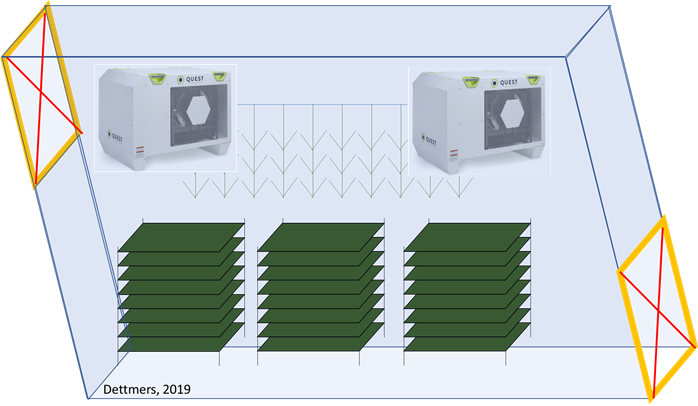
To determine the capacity of dehumidification needed, simply determine the amount of moisture left to remove over the time you want the process to complete. Using the previous example of 1,000 pounds starting at 80% moisture content, finishing at 10% and switching from “open” to “closed” at 40% moisture content gives us:
Wet weight at 80% = 1,000 lbsWet Weight at 40% = 333.3 lbsWet Weight at 10% = 222.2 lbsWater removed in “open” mode = 1,000 – 333.3 = 666.7 lbsWater to be removed in “closed” mode = 333.3 – 222.2 = 111.1 lbsIf it was desired to remove the remaining 111.1 pounds in 24 hours:
111.1 lb/24 hours = 4.6 lb/hr = 107 ppdThe reality is the last few percentages of moisture content are quite difficult to remove, so either additional time needs to be allotted or additional capacity needs to be provided.
That said, if hemp behaves similarly to hops, a relative humidity of 30% to 40% at the end of the closed cycle will be sufficient to finish the process. For the rest of the process, an RH of 50% or more will suffice.

